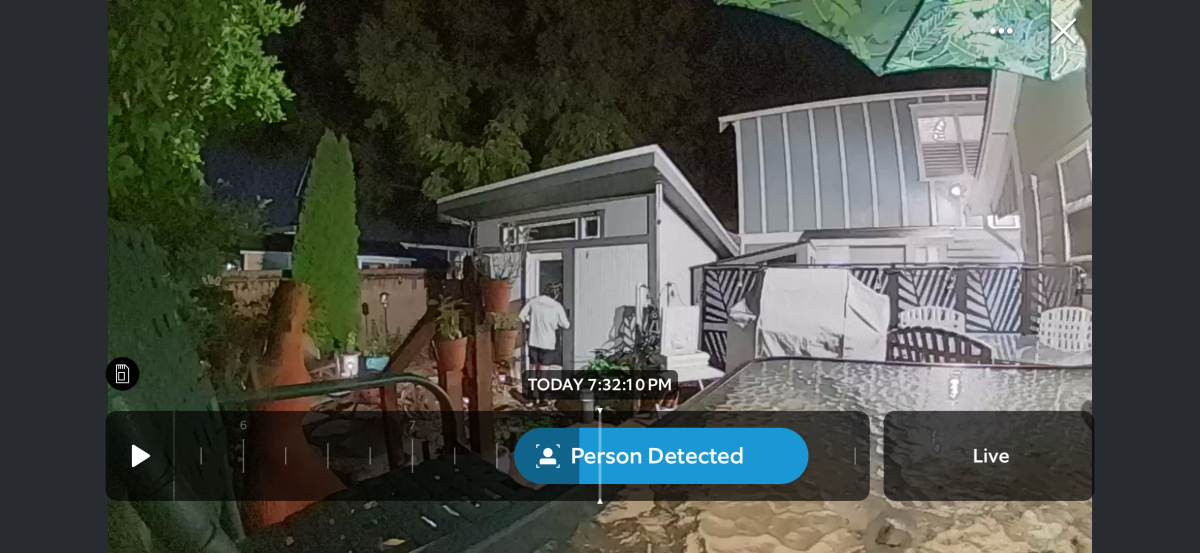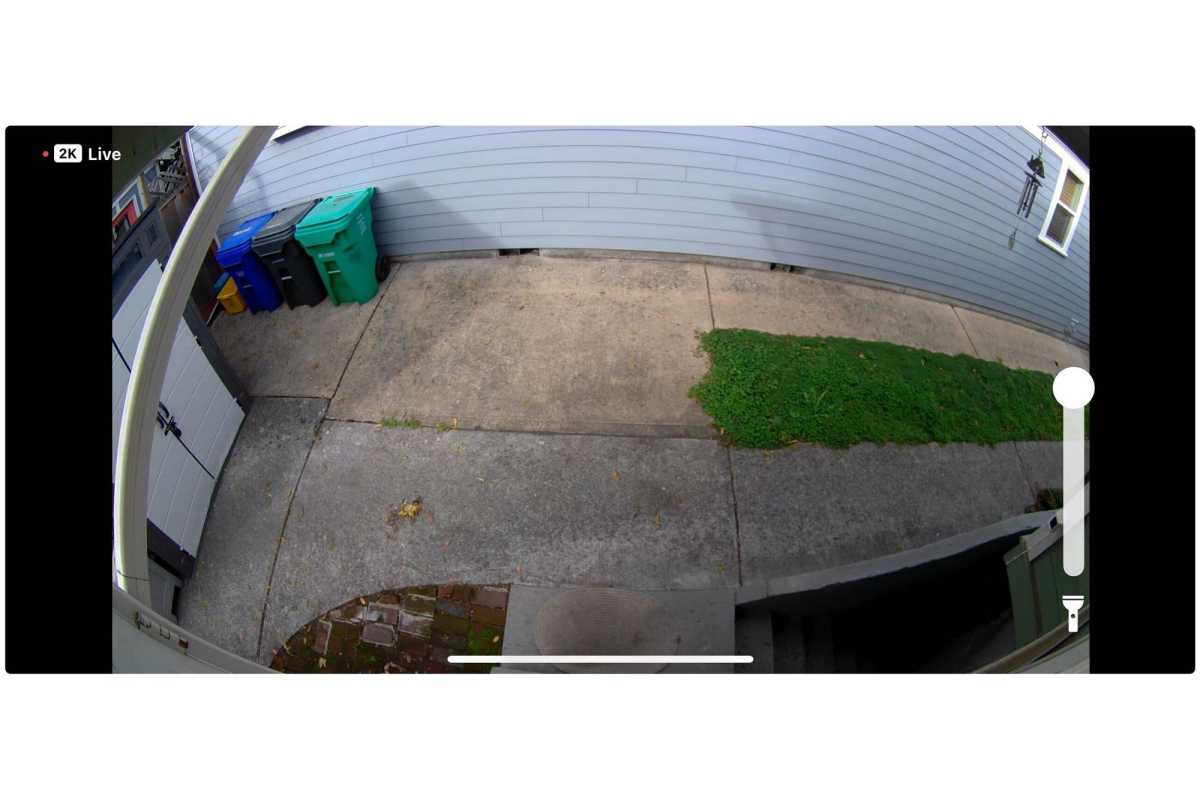Contrary to popular belief, most property crimes—including burglaries and package theft—happen during the day, not under cover of darkness. But night still brings unique challenges: fewer people around, limited visibility, and more opportunity for intruders to move unseen. If your security camera can’t see clearly after dark, you’re missing protection when you might need it most.
Night vision lets security cameras capture what the human eye can’t see in the dark. Some cameras shine invisible infrared light to illuminate a scene, while others rely on light-sensitive sensors to amplify what little light is already there. More advanced models can maintain color, adapt to changing light, or light up the scene with built-in spotlights. And there are the many camera/floodlight combos.
The following sections break down the most common types of night vision you’ll find in modern home security cameras, along with what each one does best.
Standard infrared (IR) night vision
Standard infrared (IR) night vision remains the backbone of most home security cameras. It works by using IR LEDs—infrared light-emitting diodes—positioned near the lens to flood the area with light. This light falls just beyond the visible spectrum, with wavelengths typically between 750 nanometers (nm) and 1 millimeter (mm). Most security cameras use IR LEDs that emit at 850nm or 940nm. The camera’s image sensor detects this infrared light and converts it into a black-and-white image, making it possible to see what’s happening even in complete darkness.
Black-and-white night vision on the very affordable Blink Outdoor 4 home security camera, as recorded on a Blink Sync XR.
Michael Brown/Foundry
The biggest advantage of IR night vision is reliability. It doesn’t require streetlights, porch lights, or any other source of illumination. It’s also cost-effective, which is why you’ll find it not only on almost every budget-friendly camera, but cameras at nearly any price.
Another plus: IR is discreet. Cameras that use 850nm infrared LEDs emit a faint red glow, which provides brighter and longer-range illumination, making them ideal for outdoor areas where visibility is more important than stealth. Cameras using 940nm LEDs, on the other hand, are completely invisible to the human eye and are better suited for indoor use or locations where you don’t want the IR source to be noticeable. The trade-off is that 940nm LEDs generally have shorter range and reduced brightness compared to 850nm. Unlike a bright spotlight, the faint red glow of 850nm LEDs or the invisible beam of 940nm LEDs won’t alert intruders or bother neighbors.
The downside is reduced visual detail. IR footage is always black-and-white, which makes it harder to distinguish details like clothing color or vehicle paint. The range is also limited, often topping out at around 25 to 30 feet for entry-level models.
Budget-friendly cameras often rely solely on infrared for night vision, and many do it well. Models like the Eufy Security Indoor Cam and Lorex 2K Indoor Pan-Tilt Wi-Fi Camera offer strong IR performance, providing crisp and clear footage when the lights go down.
Full-color night vision (low-light color sensors)

Michael Brown/Foundry
Full-color night vision takes a different approach from traditional IR by using low-light sensors and advanced image processing to maintain color in dim environments. Instead of switching to black-and-white when the light fades, these cameras amplify the available light, such as from a streetlamp or a porch light, to produce a more natural-looking video. The result is footage that looks closer to daytime recordings, with richer detail and less guesswork when identifying people or objects.
Starlight sensors fall into this category, but they represent the high end of performance. These cameras use larger or more sensitive CMOS chips, wide-aperture lenses, and advanced noise-reduction algorithms to produce clear color video in extremely low light—often down to 0.01 to 0.1 lux, roughly the brightness of a full moon or dim streetlight. Originally used in professional surveillance, this technology is now found in consumer cameras that deliver exceptional nighttime clarity without needing spotlights.
The biggest advantage of full-color night vision is its ability to capture key identifying details, such as the color of a car or the clothing someone is wearing. This can make a huge difference when reviewing footage as forensic evidence or sharing clips with law enforcement.
Color night vision, however, has its limits. It still needs at least some ambient light to work. In pitch-black settings, these cameras often revert to standard IR mode, resulting in black-and-white video. Some models address this by adding a built-in spotlight to provide the needed light for color capture, a feature we’ll explore in the next section.
If maintaining color footage in near-dark environments is a priority, the Annke NightChroma NC500 is a strong option. It uses a large f/1.0 aperture and a backside-illuminated (BSI) image sensor—both designed to capture more light in low-light conditions. Combined with Annke’s Acme Color Night Vision technology, the NC500 can produce full-color video even in near-total darkness, without relying on a spotlight.
Spotlight-enhanced night vision
Spotlight-enhanced night vision uses powerful built-in LEDs or floodlights to light up the scene, letting the camera record full-color video no matter how dark it is. When motion is detected, the lights kick on and provide enough illumination for the camera’s sensor to capture sharp, vivid footage, much like it would during the day.
The main benefit of spotlight-enhanced night vision is consistency. Because the camera provides its own light, you don’t have to rely on ambient sources such as porch lights or streetlamps to capture full-color video. The result is bright, detailed footage that makes it easier to identify faces, license plates, and other fine details. The sudden burst of light also acts as a visual deterrent, alerting potential intruders that they’re being recorded.
The trade-off is that these lights can be intense. They might bother neighbors if they’re triggered often, so they’re not ideal for areas with frequent activity. Spotlights also consume more power than IR or low-light sensors, which is something to keep in mind for battery-powered cameras.

Floodlight cameras, such as the Arlo Wired Floodlight Camera shown here, are just the ticket for monitoring wide spaces, such as decks, patios, driveways, and entry points.
Michael Brown/Foundry
Models like the Arlo Pro 5S 2K and Wyze Cam v4 excel in this category, providing both powerful lighting and sharp nighttime video.
If you want to light up a large area–such as a patio or deck, consider a floodlight camera like the Eufy Floodlight Camera E340 or the Ring Floodlight Cam Pro.
Choosing the right night vision mode
The best night vision mode for your home depends on where you’re placing the camera, how much light is available, and what level of detail you need.
Use standard IR night vision when you want discreet, reliable coverage—especially indoors or in shared spaces. It’s ideal for monitoring quiet areas like living rooms, offices, or apartment hallways where visible lights could be disruptive or draw unwanted attention. IR is also a smart choice for battery-powered cameras, since it consumes less power than full-color or spotlight modes.
Color night vision mode without a spotlight works well for areas like front porches or side yards where low light is present, but you don’t want to blast the area with artificial lighting. Choose spotlight-enhanced night vision when you need maximum detail in complete darkness, such as in a dark driveway, backyard, or alleyway.
When you match the right night vision mode to the environment, you’ll get sharper, more dependable footage and fewer blind spots.
Further reading: This story is part of TechHive’s in-depth coverage of the best home security cameras.

